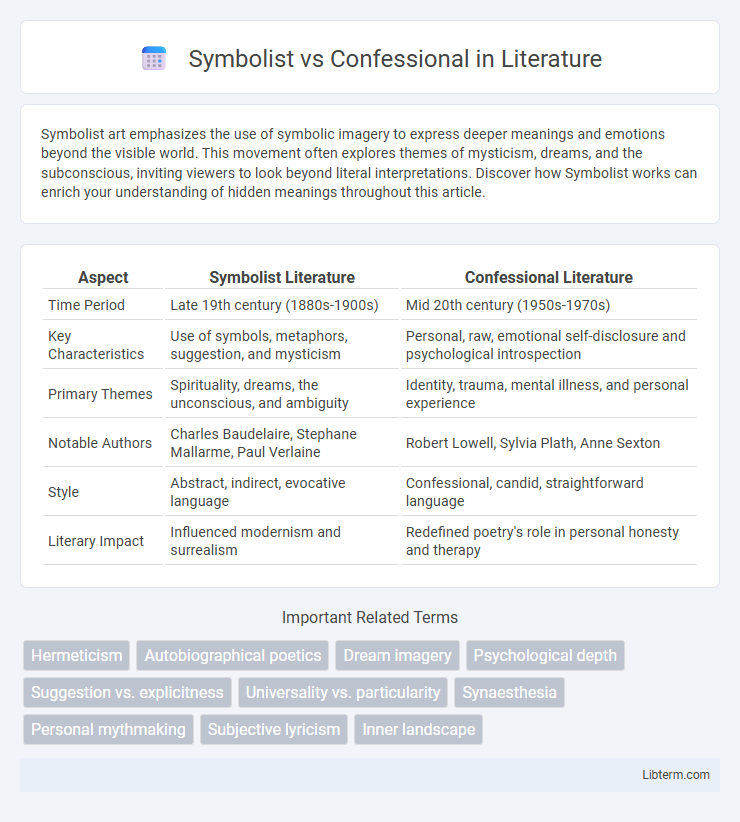Symbolist art emphasizes the use of symbolic imagery to express deeper meanings and emotions beyond the visible world. This movement often explores themes of mysticism, dreams, and the subconscious, inviting viewers to look beyond literal interpretations. Discover how Symbolist works can enrich your understanding of hidden meanings throughout this article.
Table of Comparison
| Aspect | Symbolist Literature | Confessional Literature |
|---|---|---|
| Time Period | Late 19th century (1880s-1900s) | Mid 20th century (1950s-1970s) |
| Key Characteristics | Use of symbols, metaphors, suggestion, and mysticism | Personal, raw, emotional self-disclosure and psychological introspection |
| Primary Themes | Spirituality, dreams, the unconscious, and ambiguity | Identity, trauma, mental illness, and personal experience |
| Notable Authors | Charles Baudelaire, Stephane Mallarme, Paul Verlaine | Robert Lowell, Sylvia Plath, Anne Sexton |
| Style | Abstract, indirect, evocative language | Confessional, candid, straightforward language |
| Literary Impact | Influenced modernism and surrealism | Redefined poetry's role in personal honesty and therapy |
Introduction to Symbolist and Confessional Poetry
Symbolist poetry, emerging in the late 19th century, emphasizes mystical and abstract imagery to evoke emotions and ideas beyond literal meanings. Confessional poetry, gaining prominence in the mid-20th century, centers on personal, often taboo subjects, revealing deep psychological experiences and intimate emotions. Both movements represent distinct approaches to exploring human consciousness through poetic expression.
Defining Symbolism in Literature
Symbolism in literature emphasizes the use of symbolic images and indirect suggestion to express mystical ideas, emotions, and states of mind. It originated in the late 19th century, highlighting the importance of metaphor, allegory, and synesthetic language to evoke deeper meanings beyond the literal narrative. Symbolist writers like Charles Baudelaire and Stephane Mallarme sought to reveal the hidden realities of human experience through evocative and often ambiguous symbols.
Core Principles of Confessional Poetry
Confessional poetry centers on intimate, autobiographical experiences, emphasizing personal trauma, mental illness, and emotional vulnerability as its core principles. Writers like Sylvia Plath and Robert Lowell reveal raw, often painful emotions through candid self-exploration and unfiltered expression. This contrasts with Symbolist poetry, which relies on metaphor and suggestion to evoke moods and ideas indirectly.
Historical Origins: Symbolism vs Confessionalism
Symbolism emerged in the late 19th century as a reaction against realism, rooted in French literature and art, emphasizing mysticism, dreams, and the ineffable through metaphor and allegory. Confessional poetry originated in the mid-20th century, notably in the United States, as a personal and introspective movement that revealed the poet's psychological experiences and traumas with candid self-expression. While Symbolism draws from abstract and often obscure imagery to convey universal truths, Confessionalism centers on personal life events and emotional authenticity.
Major Symbolist Poets and Their Works
Major Symbolist poets like Charles Baudelaire, Stephane Mallarme, and Paul Verlaine revolutionized poetry by emphasizing evocative imagery and suggestive symbolism to express emotions and ideas beyond literal meaning. Baudelaire's "Les Fleurs du mal" explores themes of beauty and decay, while Mallarme's complex, musical verse in "Un coup de des jamais n'abolira le hasard" highlights the power of language's ambiguity. Verlaine's intimate, melancholic poems such as "Romances sans paroles" showcase the Symbolist focus on mood and subjective experience.
Key Confessional Poets and Influential Poems
Key Confessional poets include Sylvia Plath, Robert Lowell, and Anne Sexton, known for their intense personal subject matter and emotional honesty. Influential poems such as Plath's "Daddy," Lowell's "Life Studies," and Sexton's "Her Kind" exemplify the deeply introspective and often traumatic themes central to confessional poetry. This genre contrasts Symbolism, which emphasizes metaphor and abstraction, by prioritizing raw, autobiographical content.
Thematic Differences and Motifs
Symbolist poetry often explores mystical and dreamlike themes, using symbolic imagery to evoke emotions and abstract ideas such as spirituality, death, and the unconscious mind. Confessional poetry, by contrast, centers on personal experiences and intimate emotions, revealing themes of mental illness, trauma, and identity through candid, autobiographical motifs. While Symbolist poetry emphasizes universal truths through metaphor and allusion, Confessional poetry prioritizes raw, unfiltered self-expression and psychological honesty.
Stylistic Approaches: Imagery and Language
Symbolist poetry employs rich, often ambiguous imagery and evocative language to suggest deeper meanings beyond the literal, relying on metaphor and symbolic representation to evoke emotions and ideas. Confessional poetry uses direct, candid language and explicit imagery drawn from personal experience and inner psychological states, aiming for raw emotional honesty and self-revelation. Symbolist style emphasizes mystical and universal themes through layered symbolism, while Confessional style prioritizes immediacy and personal transparency in expression.
Cultural and Literary Impact
Symbolist poetry, emerging in the late 19th century, profoundly influenced modernist literature by emphasizing metaphor, ambiguity, and the evocation of emotion through symbolic imagery, shaping artists such as T.S. Eliot and Rainer Maria Rilke. Confessional poetry, rising in the mid-20th century with figures like Sylvia Plath and Robert Lowell, revolutionized literary culture by foregrounding personal trauma, mental illness, and intimate experience, challenging traditional boundaries between public and private narratives. Both movements significantly expanded the expressive possibilities of poetry, with Symbolism contributing to abstract aesthetics and Confessionalism fostering a raw, candid exploration of identity and psychology.
Comparing Lasting Legacies
Symbolist poetry's lasting legacy lies in its influence on modernist aesthetics, emphasizing mood, metaphor, and the subconscious, shaping 20th-century literary and artistic movements. Confessional poetry's enduring impact rests on its raw, autobiographical approach, foregrounding personal trauma and mental health, which revolutionized the relationship between poet and reader. Both styles transformed poetic expression, with Symbolism expanding symbolic imagery and Confessionals fostering emotional vulnerability.
Symbolist Infographic

 libterm.com
libterm.com